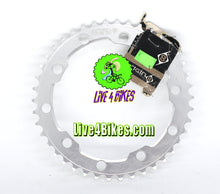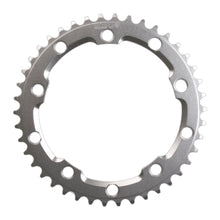Experience Unmatched Performance with our CNC Machined AL6061-T6 Alloy Chainring
Elevate your single-speed cycling game with our precision-engineered CNC Machined AL6061-T6 Alloy Chainring. Meticulously crafted from high-grade AL6061-T6 alloy, this chainring sets the bar for performance and durability.
Premium Alloy Precision: Crafted through CNC machining, our chainring is built to deliver outstanding strength and resilience. It's engineered to handle the demands of rigorous rides, ensuring a long-lasting, reliable performance.
Versatility for Every Ride: Designed to excel in all single-speed applications, this chainring offers unparalleled power transfer and efficiency. Whether you're navigating urban streets or tackling off-road trails, it's your perfect companion for a seamless ride.
Anodized Finish for Lasting Elegance: Featuring a sleek anodized finish, our chainring not only exudes a touch of elegance but also provides enhanced resistance against wear and corrosion. It's designed to maintain its pristine appearance ride after ride.
Proudly Made in the USA: Crafted with pride in the USA, this chainring embodies the highest standards of craftsmanship and engineering. Every detail is thoughtfully considered to deliver a product that stands apart in quality and performance.
Mount Compatibility: 144mm/135mm 5-Bolt
Teeth: 42T
Material: AL6061
Color: Silver
Chain Compatibility: 1/2" x 1/8"
Tooth Type: Standard
Upgrade your ride with our CNC Machined AL6061-T6 Alloy Chainring. Precision-engineered for performance, built to endure, and proudly crafted in the USA. Elevate your cycling experience today!

Bicycle chainrings play a crucial role in the efficiency and performance of your bike. They are the toothed rings that attach to your crankset and engage with the bicycle chain. When it's time to replace a worn-out or damaged chainring, it's important to understand what factors to consider. In this guide, we'll cover the key aspects you need to keep in mind when buying a replacement.
1. Understanding Chainring Basics
a. Chainring Size
Chainrings are measured by the number of teeth they have. For example, a chainring with 52 teeth is larger than one with 42 teeth. The size affects the gearing ratio, influencing how easy or hard it is to pedal.
b. BCD (Bolt Circle Diameter)

This is a crucial measurement to get right. The BCD is the diameter of the circle that passes through the centers of the chainring bolts. It's important because it determines whether a chainring will fit on your crankset. Common BCD sizes include 110mm, 130mm, and 144mm, but there are others as well.

2. What to Measure
a. Number of Bolts
Check how many bolts secure your chainring to the crankset. This is typically either 4 or 5 bolts. It's important to get a replacement with the same number of bolts to ensure a secure fit.
b. BCD Measurement
To measure BCD, you'll need a ruler or caliper. Place one arm on the center of a bolt hole and measure to the center of the hole directly opposite. If you're not confident in your measurement, it's best to consult a professional or use specialized tools.

|
 |
 |
3. Things to Ensure Match
a. BCD Compatibility
Ensure that the BCD of your new chainring matches the BCD of your crankset. A chainring with the wrong BCD will not fit properly and can lead to poor shifting and potential damage.
b. Teeth Count
If you're happy with your current gear ratios, it's a good idea to stick with a similar number of teeth on your replacement chainring. However, if you want to adjust your gear ratios, you can experiment with different tooth counts.

|
 |
 |
a. Ignoring Wear and Tear
Don't delay replacing a worn chainring. A worn chainring can lead to poor shifting, chain slippage, and accelerated wear on other drivetrain components.
b. Mixing Incompatible Components
Avoid trying to force a chainring with the wrong BCD onto your crankset. This can lead to damage to both the chainring and the crankset.
Choosing the right replacement chainring involves understanding key measurements like BCD, teeth count, and bolt number. It's crucial to ensure compatibility with your existing components to maintain smooth and efficient operation. Remember, if you're uncertain, seeking advice from a professional at your local bike shop is always a wise move. With the right replacement, your bike will continue to perform at its best.






